
Photo : Yojak Tamang
Introduction by Prava Rai.
Jamyang Dorjee is a senior ideologue-practitioner of Tibetan calligraphy. He was born in Lhasa and fled with his family after the Chinese takeover of Tibet in 1959. His family settled down in Ravangla, Sikkim along with other Tibetan exiles on a plot allotted to them by the Chogyal of Sikkim. Initially he attended the Central School for Tibetans (CST) Shimla in Himachal Pradesh before moving to another school and then attending college in Delhi. After completing his Bachelor in Arts, he returned to Sikkim and worked as a teacher in Kewzing tea garden school established by the Chogyal of Sikkim. Subsequently, he joined the Department of Tourism and Culture, Government of Sikkim as a senior research officer. During his tenure as the Joint Secretary of Culture he was a core member of the organising committee for the Kala Chakra Puja in 1993, which was presided over by His Holiness the Dalai Lama.
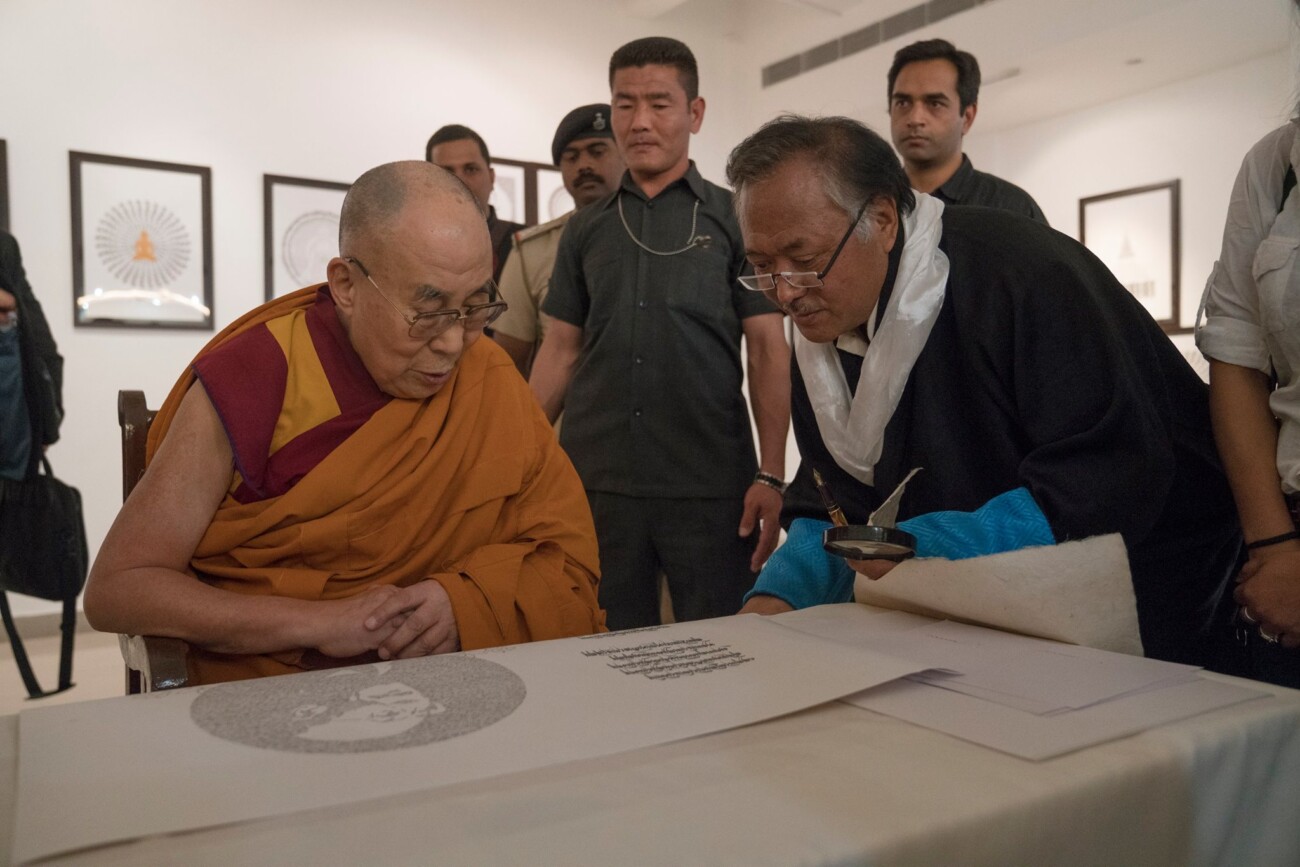
Photo Courtesy : Jamyang Dorjee (Facebook Page)
His Holiness requested the then Chief Minister, Nar Bahadur Bhandari to send Jamyang Dorjee on deputation to work in his Government in Exile in Dharamsala. The deputation, which was intended for a few years, eventually extended to twelve long years of engagement with the Tibetan administration and promotion of Tibetan cultural activities. As the director of the prestigious Tibetan Institute of Performing Arts Jamyang supervised troupes to different parts of the world, creating awareness about Tibetan culture. He also worked as an administrator, promoting the teachings of His Holiness.
Upon his return to Sikkim in 1986, he took voluntary retirement and it was then that his exploration of Tibetan calligraphy and his inner spiritual journey began.

Photo : Yojak Tamang
I met Jamyang Dorjee at his residence in Ravangla, Sikkim in April 2022. During our conversation he spoke extensively about his life before and after he began his serious engagement with Tibetan calligraphy.
“ After retirement I engaged into serious Buddhist practices and realized how vast Buddhist philosophy is. I began looking inward within myself, there is a beauty; my story would inspire many retirees. When they (people) retire they feel that they have nothing to do. But now is the time when you can express yourselves.”
He said that retirement also gave him the time to reflect and pursue a spiritual path through the practice of calligraphy. Jamyang Dorjee came to limelight in 2010 when he completed a 165 meter long Tibetan calligraphy, in an attempt to break what he mistakenly thought was the Shanghai announcement of the world’s longest Tibetan calligraphy of 150 meters length. When he decided to break this record, he was unsure about what to write. He discovered that the current Dalai Lama is the only spiritual leader for whom all the different schools of Buddhism said long life prayer for. The prayers were collected into two volumes. He decided to write this. He thought, “I will take my own time, nobody is chasing me. I went to Kathmandu and began working there on Nepali handmade paper”. Within six months, he had completed the 165 meters long calligraphy. “My friend, Tendharla Kunchok, appliqué master who later created Zamling Yuthang Chenmo, world’s biggest turquoise thanka at Pemayangtse monastery, came and made a big box roll to store the scroll”.
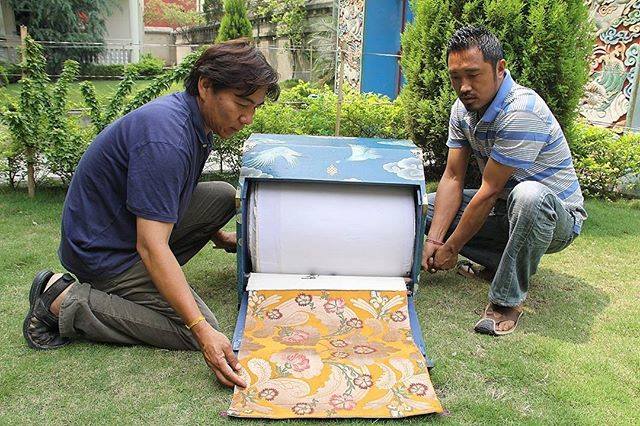
Photo Courtesy : Jamyang Dorjee (Facebook Page)
Jamyang Dorjee took the scroll to New York and applied for the Guinness Record. He was told that the Guinness record was awarded in the UK. In the UK, they informed him that there was no such record to break as it turned out to be Chinese calligraphy and not Tibetan. So, they asked him to apply for the longest calligraphy in the world. It took two months to complete the formalities. After two months, there were news reports in the local papers, stating that Ravangla’s Jamyang Dorjee had created the longest calligraphy in the world. “I suddenly became famous”, he added with a chuckle. “This drew attention to Tibetan calligraphy. Tibetans in Tibet and around the world were proud of my achievement and inspired by it, they formed the Tibetan Calligraphy Associations and began organizing competition amongst themselves.” In 2017 they declared April 30th as “ 4 Vowels and 40 Consonants Day”. The Chinese government also patronised their new initiative.
Talking about Tibetan calligraphy he says that, “The act of calligraphy is a spiritual exercise…. Through the act of writing I try to create something beautiful.”
He has also contributed towards promotion of Buddhism in Sikkim by constructing a stupa at Khado Sangpo, Legship and the statue of Guru Rinpoche at Khecheopalri. Currently he patronises Lhatsun Dharma Centre in his hometown Ravangla, which has greatly benefited the local Buddhists.
Below we reproduce his reflections on his art.
Tibetan Calligraphy: A Buddhist Pilgrimage
Jamyang Dorjee

Photo : Yojak Tamang
Calligraphy means beautiful writing. They call it 'shufan,' a way of writing. In China, and from a very early period, calligraphy was considered not just a form of decorative art; instead, it was viewed as the top visual art form, more valued than painting and sculpture, and ranked alongside poetry. Chinese calligraphy and poetry found international recognition as one of the most beautiful traditional arts, with dedicated connoisseurs, and more people became its collectors.
Thönmi Sambhota, one of the most capable ministers of the Tibetan rulers in the 7th century, was sent to India to develop an alphabet suitable for the Tibetan language. Thönmi derived the new script from the Devanagari script used in India.
Throughout the centuries, our ancestors have developed at least 100 different styles of writing, broadly categorised as Uchen, Umed, and Druktsa styles. However, Tibet devoted its entire state machinery and resources of the kingdom in developing the Buddhist philosophy of 'science of the mind' to benefit sentient beings.
Some 70,000 pages of Kangyur (‘Translated Words of Buddha) and 161,800 pages of Tengyur (Translated Treatises) were translated from Sanskrit to Tibetan. From a secular perspective, Tibet produced many great scholars who wrote poetry, literature, philosophy, metaphysics, medicine, and astro-science, with only one objective in mind: benefiting others.
Writings of great scholars like Je Tsongkhapa, songs of Milarepa, compositions by Sakya and Nyingma masters are relevant and are studied in all the monasteries even to this day.
Unfortunately, anything other than spiritual practice, such as art and entertainment,was neglected.
What is Art?
Art is a visual or vocal expression of the innate feeling of an artist from his heart, unstructured, boundless and spontaneous.
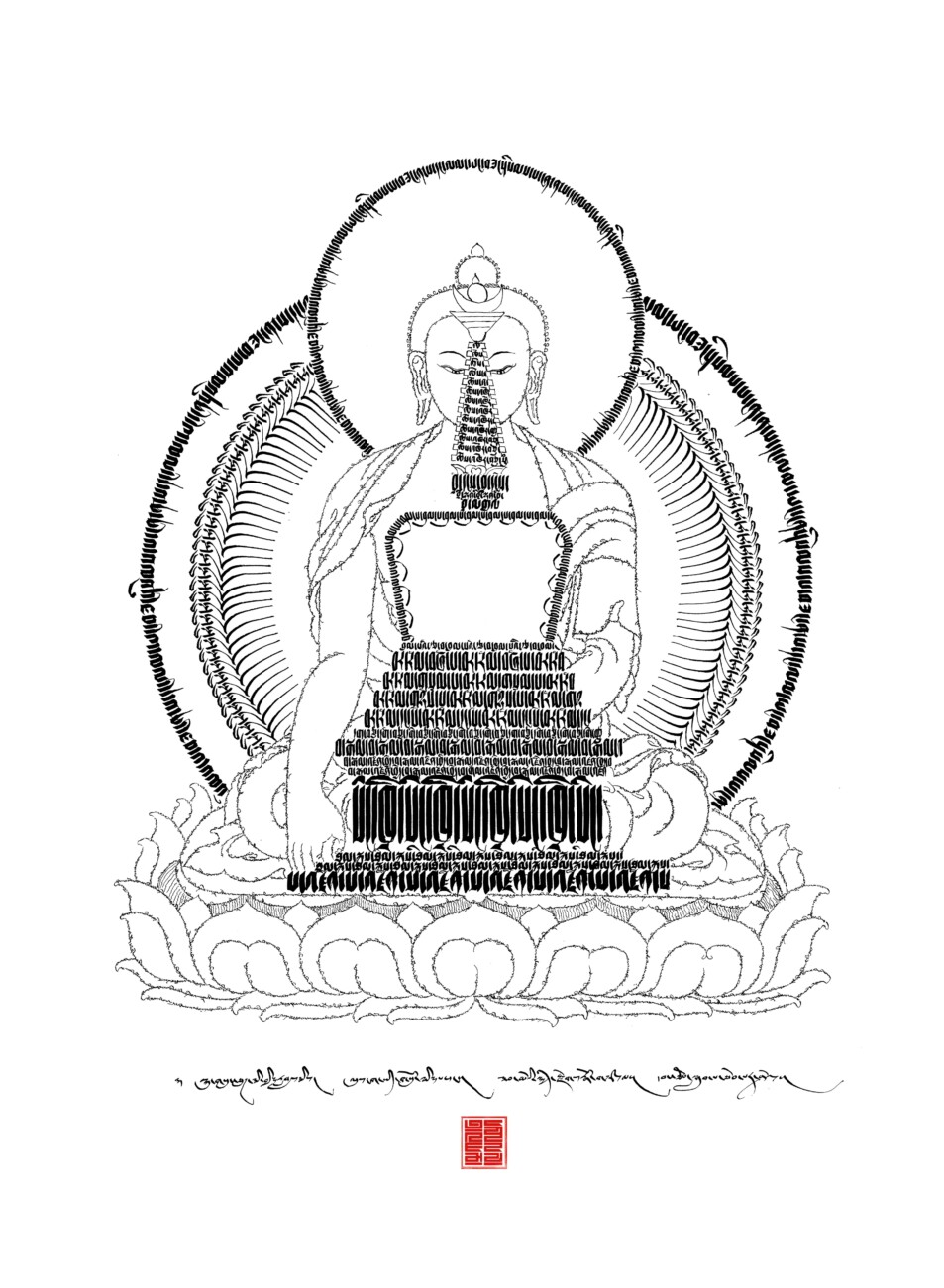
Art is a visual or vocal expression of the innate feeling of an artist from his heart, unstructured, boundless and spontaneous. At the same time, craft refers to an activity, which involves creating tangible objects with the use of hands and the brain.
Tibetan calligraphy, or beautiful writing, is a skill that can be practiced, perfected, and reproduced. Yig tsal, or the art of writing, cannot be reproduced. It is an art. I wanted to emphasise the importance of a Yig tsal platform, which is equivalent to 'Shodo' of Japan and 'Shufan' of China.
I use 'kyug style', a form of a cursive script of the central Tibet region for calligraphy art. The cursive script has more flexibility, for it only maintains the essence of each character and expresses more personal exertion. Therefore, its value lies in appreciation, of beholding, more than practicality. At the same time, the running hand makes full use of connecting lines between two strokes.
Watching art is also an art. The process of creating beautiful art, from conceiving an idea to the final expression on paper, is a profound meditative process. Art is a visual expression of the sound of the heart of an artist, and if the 'tsa lung', perhaps called the 'Chi' energy of an artist, is balanced and steady, the resultant visual art becomes a masterpiece.
I would call this a Calligrapher's Journey into the nature of mind.
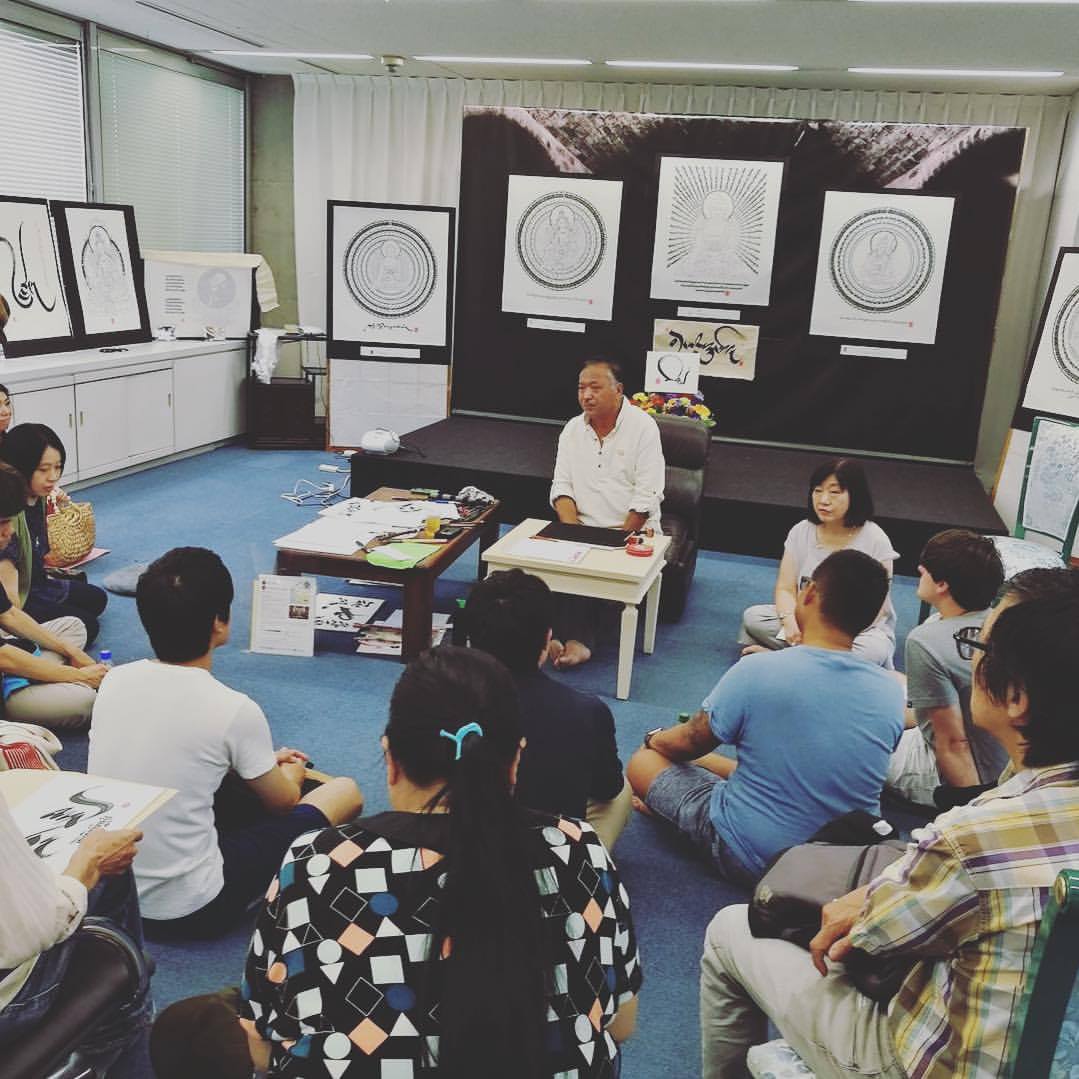
Photo Courtesy: Jamyang Dorjee (Facebook Page)
Some say 'calligraphy speaks’. I have created more than 200 styles of calligraphy art, and often, friends ask me: "How did you get so many ideas?” I say lightly that Guru Rinpoche has opened his treasure trove to me! But honestly speaking, I have asked the same question to myself again and again. And only now, am I beginning to learn the answer. My experience is that I do not get two ideas at the same time. Only when I complete executing one work, put my seal on it, that there is a blank or emptiness. Slowly, the next idea takes shape. I know that the void or the blank is vast, like an ocean. It indeed is the treasure trove of wisdom, limitless, and like a child with a small cup in hand, I stand at the shore of this ocean, not strong enough to go nearer and fetch water but confident that when the wind gushes, a drop will fall into my cup. These droplets are the result of my collected works.
When I shared my personal experience with my Spiritual Master, Tsoknyi Rinpoche, he beautifully explained the following, which awakened my consciousness and put my thoughts into proper perspective.
I would call this a Calligrapher's Journey into the nature of mind.
Rinpoche says that there are four types of letters:
- A letter that rests on the natural state of mind
- A letter on 'nadi' ( རྩ) energy or 'tsa' that moves with 'prana' ( རླུང་), or the wind energy in the physical body
- A letter that produces sound with the result of the movement of that wind energy
- The final expression of the artist is in the form of calligraphy.
We believe that our 'nature of mind’ is primordially pure, clear, and vast as the sky. It also holds wisdom that can dispel ignorance. A letter is a medium to contact and to impart information, and dispel ignorance.
Sacred Journey
Let us look at how this journey from 'nature of mind' to the visual form on the paper takes place.
The artist sits down in a state of calmness and tries to look within the mind's nature. He picks up a droplet from the ocean of wisdom. He then brings it to his own physical body and evokes the letter energy on his 'tsa' (རྩ) or the wind energy or the 'lung' ( རླུང་), whose nature is always moving, takes the letter on 'tsa' and converts it into a letter of sound.

Photo : Yojak Tamang
By using the necessary tools, such as brush, ink stick, paper, and ink slab, which the Chinese calligraphy masters call the 'four treasures of study,' and converts the letter of sound into the form of a letter, called calligraphy. This way, he expresses the inner world in an aesthetic sense for others to behold.
It is almost a sacred journey that few people can appreciate. It is an art to look at art, and only those who understand can fully marvel at such works.
Similarly, when you have such art on your wall, you can study it carefully, the strength of strokes, the darker and lighter shades of inks, the writing flow, and most importantly, the message it is trying to convey.
The viewer can retrace the calligraphy art in the form of its root, sound, letter on your 'tsa lung' and finally to the vastness, pureness of the nature of mind.
Buddhism
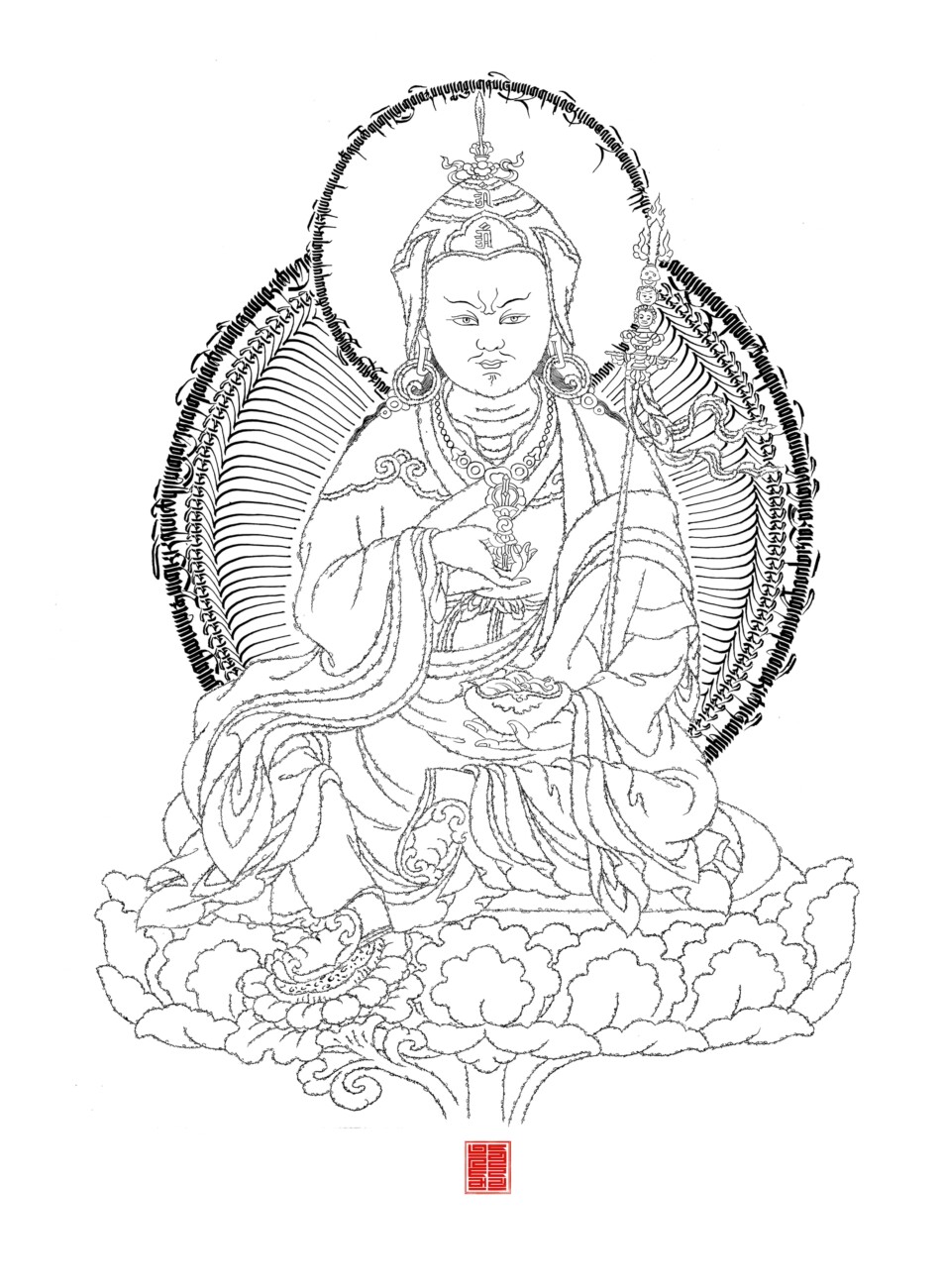
Our masters have, over the centuries, introduced varieties of skilful means to teach Buddhism by introducing many kinds of deities by way of statues and thankas (spiritual scrolls), each for wealth, knowledge, strength, compassion and long life, etc. Ultimately all these deities dissolve into your heart, and just like you put a drop of water into oceans, it becomes one with the ocean, inseparable.
Therefore, practicing calligraphy art is also a skilful means to see your nature of mind, which is the ultimate goal of all Buddhist teachings. It is the best tool to practice mindfulness besides promoting a unique traditional art. It is a gem that we often ignore. I hope the next generation will have some sense of what I am trying to say. Yet, I would still say that to watch art is also an art.
*Je Tsonkhapa (1357 to 1419) was a great Buddhist scholar, whose works laid the foundation of the Gelug school of Tibetan Buddhism. Milarepa (circa 1028 to 1111) was the venerable Tibetan siddha, or “Perfected Master”, and is the most accomplished pupil of Marpa, the “Great Translator”, who worked on original Sanskrit Buddhist texts.
PHOTO GALLERY
(CLICK TO ENLARGE)


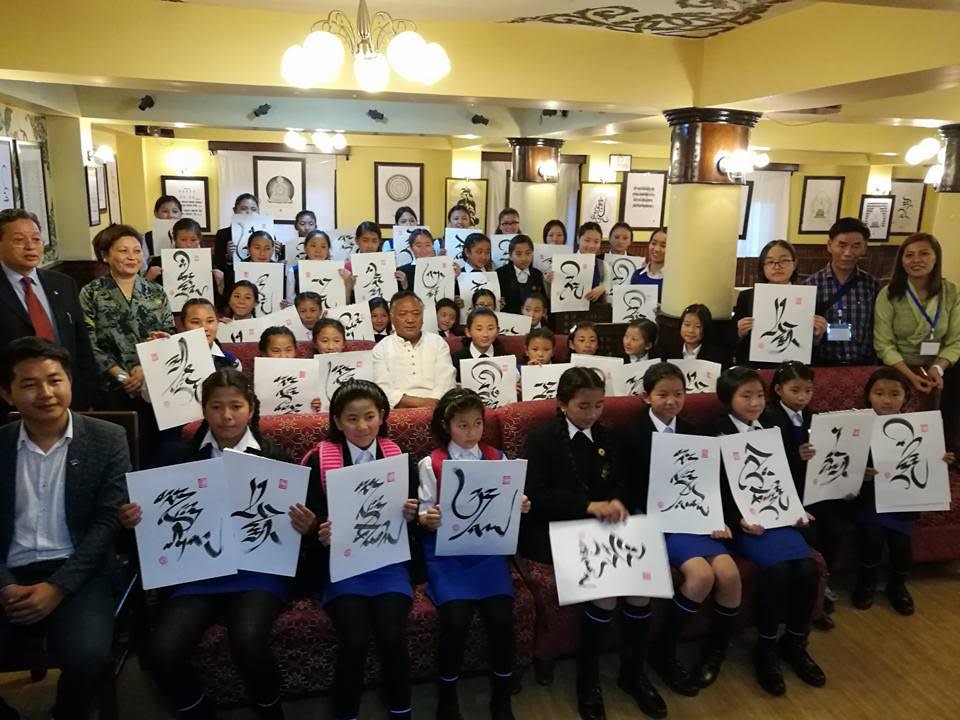


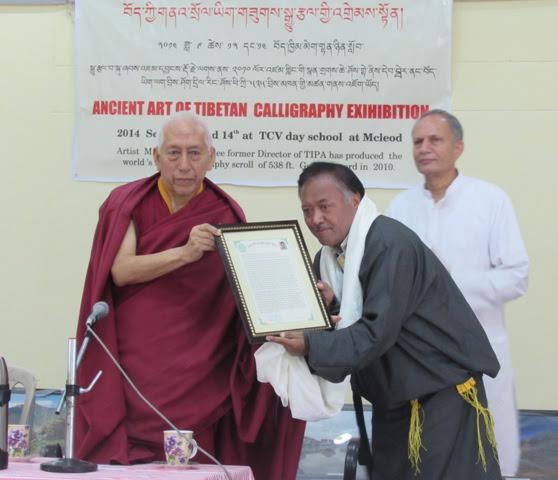
Jamyang Dorjee Chakrishar is a Tibetan Calligrapher and a teacher. Hehas studied under great masters Geshe Lobsang Tharchin and Professor Samdhong Rinpoche in School in Shimla, India. In 2010, he wrote a 165 meter-long Tibetan calligraphy, creating a world record for the longest calligraphy scroll in the world.
His calligraphy art or dharma art, has been exhibited all over the world.


I want to learn tibetan caligraphy. How cab I ?